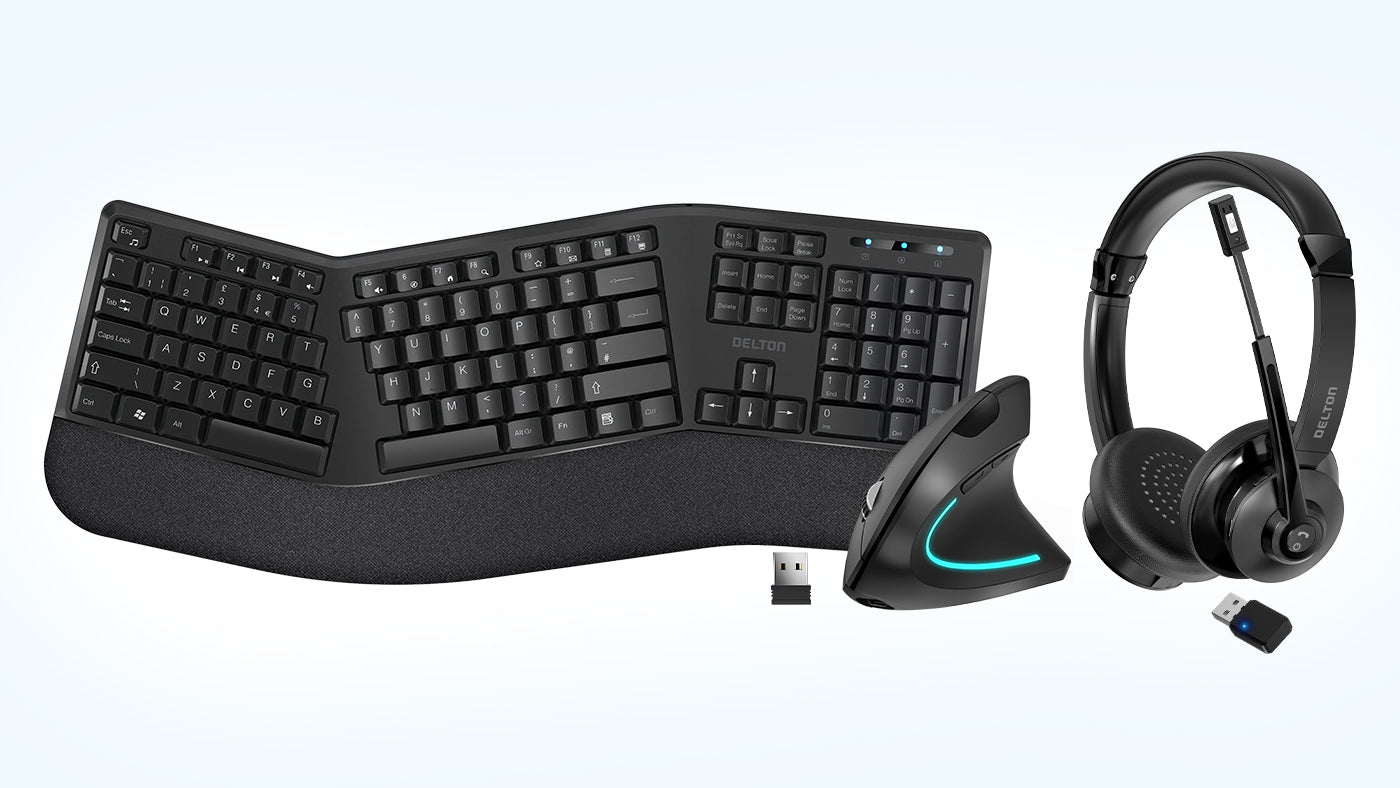Welcome to the world of computer ergonomics. You can enhance both your health and productivity by simply upgrading your workstation and switching to ergonomic computer peripherals and equipment. Ergonomics, or human engineering, is not just simply a buzzword accompanied by futuristic-looking gadgets, it’s also being friendly to your future self. Meaning your future self will thank you because you made sure that you won’t suffer work-related musculoskeletal disorders (WMSDs) by investing in ergonomic equipment and computer peripherals.
By investing in ergonomic equipment like chairs as well as height-adjustable desks, and ergonomic mouse and keyboard, you can reduce the risk of repetitive strain injuries (RSI) and other health issues while also improving your overall efficiency and comfort. Join us as we explore the benefits of ergonomic computing and how our products can boost your health and productivity with ergonomic computer peripherals.
The Importance of Ergonomics for Your Health and Productivity
According to the Encyclopedia Britannica, human-factors engineering, or more popularly known as ergonomics, is a science “dealing with the application of information on physical and psychological characteristics to the design of devices and systems for human use.” In human words, as Philomena Cunk would put it, it’s all about designing products and environments that are fit for human needs, abilities, and limitations. In the context of computer use, ergonomics involves designing computer peripherals, such as keyboards and mice, that are comfortable, efficient, and safe for the user. The importance of ergonomics for your health and productivity cannot be overstated. As we spend more and more time working at computers, the risk of developing musculoskeletal disorders, such as RSI, tendinitis, and neck and back pain, increases. These injuries can be painful, debilitating, and can significantly impact productivity and quality of life.
Investing in ergonomic computer peripherals, such as ergonomic mice and keyboards, can help to reduce the risk of developing these injuries by reducing muscle strain, fatigue, and discomfort. Even small businesses, particularly those who can’t afford to lose critical and or specialist workforce would find it worthwhile to provide staff with ergonomic equipment and computer peripherals. Properly designed ergonomic peripherals can also improve posture, reduce eye strain, and increase typing speed and accuracy, leading to improved efficiency and productivity. Additionally, ergonomic peripherals can help to reduce the need for breaks and interruptions due to discomfort or pain, allowing you to work longer and more comfortably.
The Benefits of Proper Posture and How Ergonomic Computer Peripherals Can Help
It can be challenging to maintain good posture when using a traditional mouse and keyboard, which often require awkward arm and wrist positions. This is where ergonomic equipment, such as ergonomic mice and keyboards, can be extremely beneficial.
Ergonomic equipment is designed to help you maintain proper posture while using a computer. For example, ergonomic keyboards are designed to keep your hands and wrists in a neutral position, reducing strain on the forearms and reducing the risk of developing carpal tunnel syndrome. Ergonomic mice, such as vertical mice, are designed to keep your arm in a more natural position, reducing muscle strain and fatigue. Ergonomic vertical mouse promotes natural hand positions, without subjecting workers to long hours of wrist pronation.
Using ergonomic equipment can even help in alleviating pain and discomfort in those who are already experiencing symptoms of work-related musculoskeletal disorders.
Ergonomic Keyboard Features That Can Improve Your Typing Comfort and Speed:
- Split keyboards: Separates the keyboard into two halves, allowing for a more natural hand and wrist position and reducing strain on the forearms and shoulders.
- Cushioned palm rest: Provides support and cushioning for your palms, reducing strain on the wrists and hands.
- Soft-touch keys: Keys that require less force to depress, reducing muscle strain and fatigue and increasing typing speed.
- Programmable hotkeys: Allows you to program frequently used commands or macros, reducing the need for reaching and improving overall productivity.
- Ergonomic key layout: Places frequently used keys in easier-to-reach locations, reducing the need for stretching or contorting your fingers and reducing strain on the hands and wrists.
- Curved or angled design: Allows for a more natural hand and wrist position, reducing muscle strain and fatigue.
- Quiet typing: Reduces noise and the impact of typing, which can reduce strain and improve typing accuracy.
- Wireless connectivity: Provides more flexibility in terms of placement and reduces clutter on your workspace.
 These features can improve your typing comfort and speed, reduce muscle strain and fatigue, and reduce the risk of developing WMSDs, such as Distal upper extremity (DUE). By investing in an ergonomic keyboard with these features, you ensure that you can not only improve your typing experience and increase productivity, you’re also investing in your future and current health.
These features can improve your typing comfort and speed, reduce muscle strain and fatigue, and reduce the risk of developing WMSDs, such as Distal upper extremity (DUE). By investing in an ergonomic keyboard with these features, you ensure that you can not only improve your typing experience and increase productivity, you’re also investing in your future and current health.
How Ergonomic Mice Can Reduce Hand and Wrist Strain During Computer Use
Ergonomic mice come in a variety of shapes and sizes, but some of the most common designs include vertical mice, trackballs, and mice with adjustable angles. Vertical mice, for example, are designed to keep the hand and wrist in a more natural, upright position. Notice that when you rest your forearms on a table, it naturally falls into what’s called a “handshake” position. Conventional mice requires you to contort your wrist for hours at a time, which vertical ergonomic mice doesn’t do. This natural hand and wrist position allows for more precise movements and control, which can be invaluable for specialist workforce that requires pinpoint mouse tracking. By investing in an ergonomic mouse, you can reduce the risk of developing hand and wrist strain, alleviate pain and discomfort (for those already affected by WMSDs), and increase productivity. 
Investing in Your Health and Productivity: Why Ergonomic Computer Peripherals are Worth It
Research has consistently shown that ergonomic equipment can have a significant positive impact on our health and well-being, and this is particularly true when it comes to computer use.
While the initial investment in ergonomic equipment may be higher than traditional equipment, the long-term benefits far outweigh the costs. With increased comfort and reduced strain on your body, you can work for longer periods of time without experiencing pain or discomfort, leading to increased productivity and ultimately a better quality of life. Think of the money that will go down the drain should prolonged computer use affect your body and because of the conventional computer peripherals you were using. So, whether you're a professional who spends hours at a desk each day, or a business owner who does not want to lose manhours due to WMSDs, investing in ergonomic computer peripherals is a wise choice that will pay dividends for years to come. Your future self will thank you.









Leave a comment
This site is protected by hCaptcha and the hCaptcha Privacy Policy and Terms of Service apply.